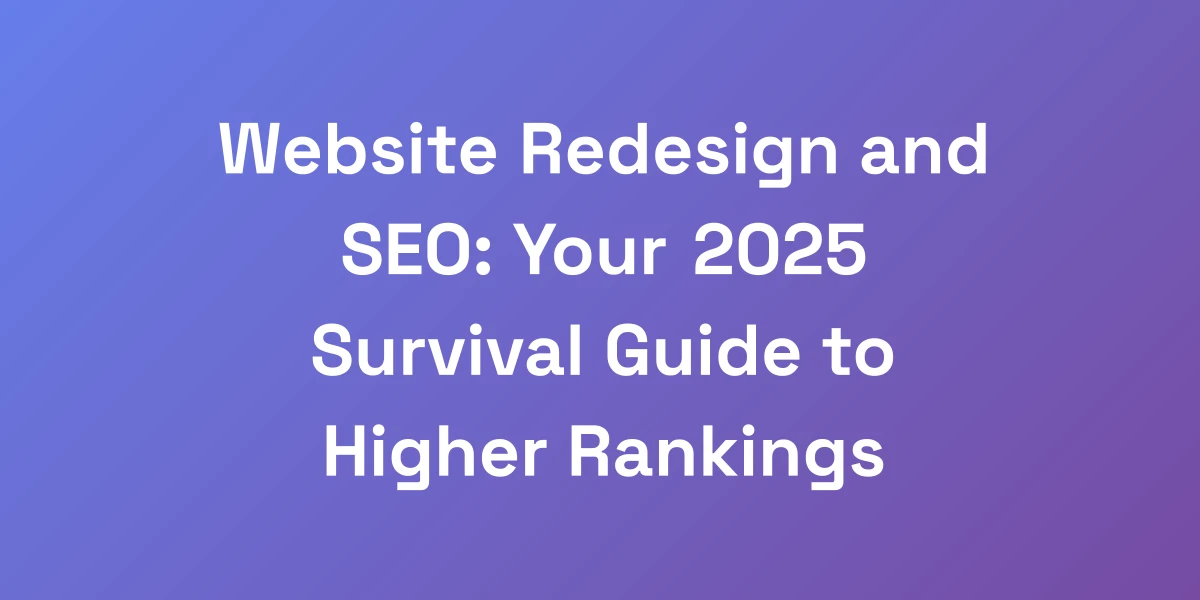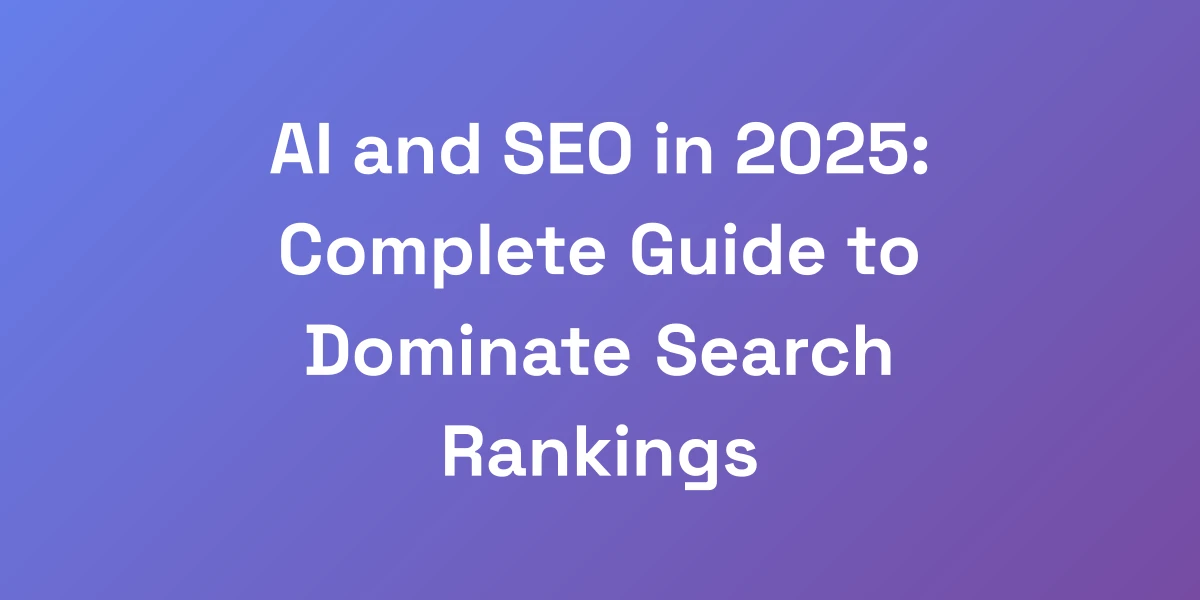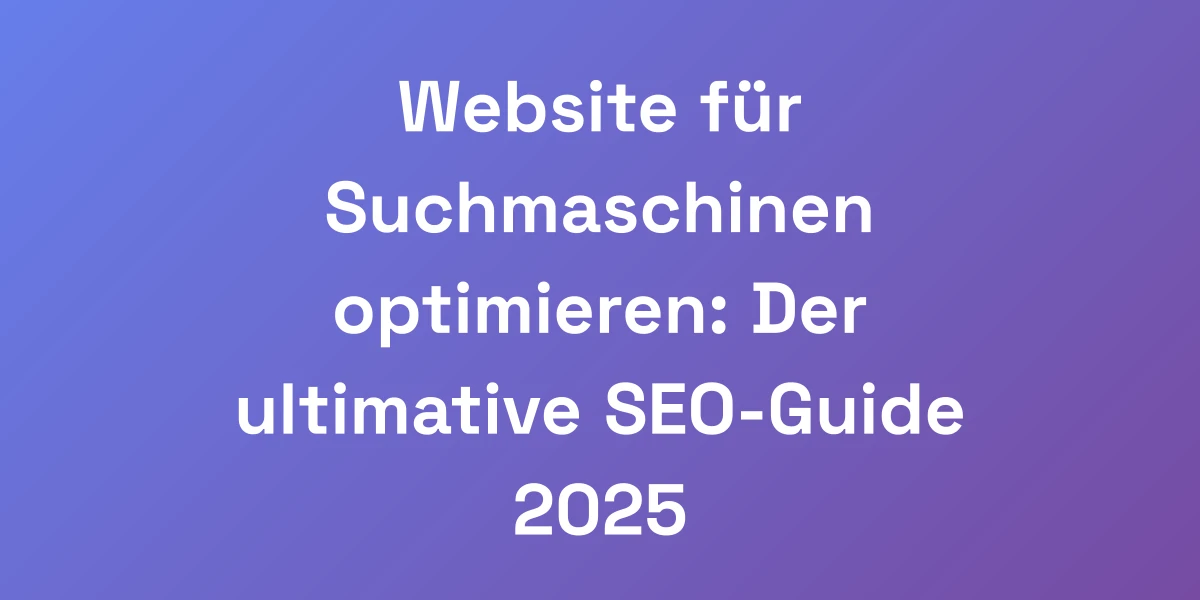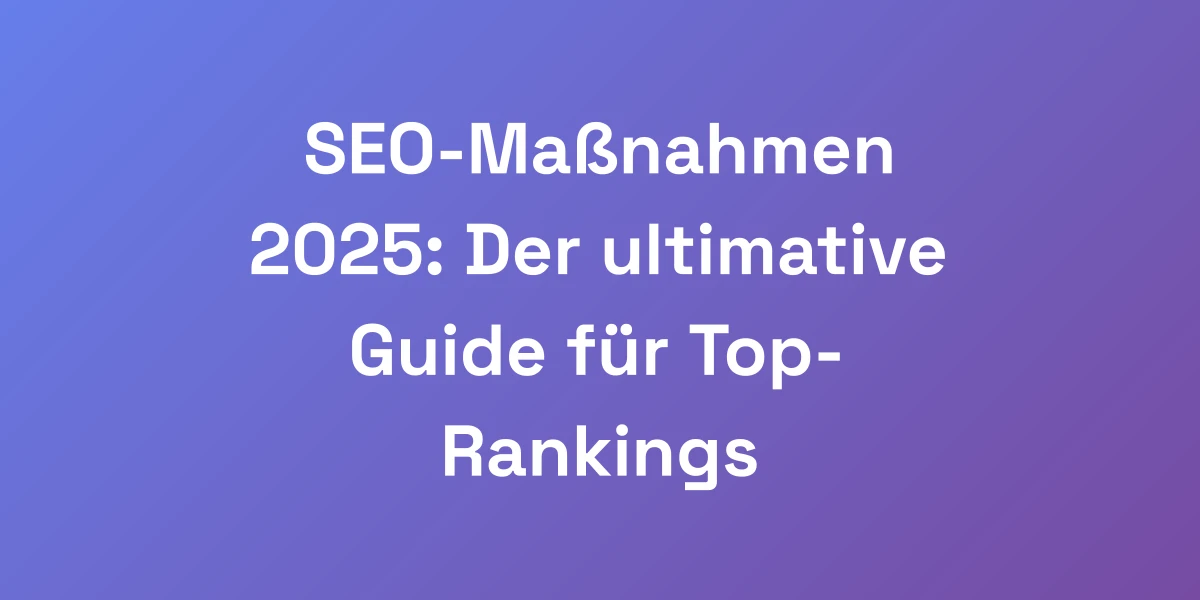
Website Redesign and SEO: Your 2025 Survival Guide to Higher Rankings
Mar 16, 2025 | By [email protected]
Introduction
Ever felt like your website redesign is a gamble where SEO is the unsuspecting pawn?
You’re not alone.
In the fast-paced digital arena of 2025, a mere facelift can doom your site’s search rankings.
93% of website redesigns fail to maintain or improve their SEO rankings. That’s not just a number; it’s a seismic wake-up call.
Imagine pouring resources into a stunning new design, only to watch your organic traffic plummet. Frustrating, right?
But here’s the kicker: it doesn’t have to be that way.
We’re diving deep into the trenches of website redesign and SEO, unmasking the challenges and revealing the strategies that separate the top 7% from the rest.
Ready to safeguard your SEO equity and skyrocket your rankings?
Let’s get started.
Why Most Website Redesigns Absolutely Destroy SEO (And How to Avoid It)
Let me hit you with some truth: 93% of website redesigns fail to maintain or improve their SEO rankings. Why? Because most businesses treat their redesign like a cosmetic facelift when it’s actually open-heart surgery.
Your website’s SEO equity is worth more than gold, and I’m going to show you exactly how to protect and multiply it during your redesign.
The difference between success and failure isn’t luck – it’s systematic execution. Here’s what the top 7% are doing differently, and why it matters more than ever in 2025. Understanding the Google ranking factors is crucial in this process.
The Hidden Cost of SEO Negligence During Redesign
Neglecting SEO during a redesign isn’t just a misstep; it’s a full-blown catastrophe waiting to happen.
When you overlook SEO, you risk losing high-value backlinks, de-indexing vital pages, and dropping those precious rankings that took years to build.
- Loss of Backlinks: These are the lifeblood of your SEO strategy. Without proper management, you could sink valuable link equity.
- De-Indexed Pages: Changing URLs without redirects? Say goodbye to your hard-earned pages on search engines.
- Traffic Plummet: Reduced visibility directly translates to a drop in organic traffic, affecting your bottom line.
Think of your SEO as the foundation of a house. A redesign without SEO is like renovating the facade without reinforcing the base – it might look great, but it’s structurally unsound.
Critical Metrics You Must Track Before Touching Any Code
Before you even think about changing a single pixel, you need to know where you stand.
Tracking the right metrics is your roadmap to a successful redesign.
- Organic Traffic: Understand your baseline traffic to measure the impact of your redesign.
- Keyword Rankings: Identify which keywords are driving traffic and ensure they’re prioritized in the new design.
- Website Audit Tools: Audit your backlinks to prevent losing valuable link equity.
- Conversion Rates: Know what’s converting and make sure those pathways remain intact.
Without these metrics, you’re flying blind. It’s like trying to navigate a ship without a compass – possible, but not advisable.
Why Your Designer Doesn’t Understand SEO (And Why That’s Dangerous)
Designers are fantastic at creating visually appealing sites, but SEO is a different beast altogether.
Here’s the problem: a beautiful site is useless if it can’t be found.
- Page Speed: Heavy designs can slow down your site, hurting your rankings.
- Mobile Optimization: A non-responsive design will alienate the majority of your users.
- Structure and Hierarchy: Proper heading structures and internal linking are often overlooked.
This disconnect between design and SEO can lead to disastrous outcomes.
We need a symbiotic relationship where design enhances SEO, not hinders it.
The New Google Algorithm Updates That Change Everything
Google is relentless in its pursuit of the best user experience, making its algorithm updates more disruptive than ever.
Stay ahead by understanding Google algorithm updates: history and latest changes:
- August 2024 Core Update: Focuses on rewarding helpful content and reducing low-quality content.
- March 2024 Core Update: Emphasizes high-quality, user-centric content and may lead to ranking volatility.
- March 2024 Spam Update: Targets spammy practices, ensuring only reputable sites thrive.
- September 2023 Helpful Content Update: Promotes authentic, user-focused content across various sectors.
These updates mean that your redesign must not only preserve existing strengths but also align with Google’s evolving priorities.
Adaptability is key. If your redesign doesn’t account for these changes, you could see your rankings tumble.
Case Study: How We Increased Traffic 312% Post-Redesign
Let’s talk numbers.
We partnered with a client who was on the brink of abandoning their redesign due to a severe traffic drop.
What did we do?
- Comprehensive SEO Audit: Identified and preserved high-value pages and backlinks using the best SEO tools for agencies.
- Content Optimization: Enhanced existing content with targeted keywords and improved readability.
- Technical Enhancements: Improved site speed, mobile responsiveness, and implemented structured data.
- Strategic Redirects: Ensured all old URLs seamlessly redirected to new ones, preserving link equity.
The result? A staggering 312% increase in organic traffic within six months post-redesign.
This isn’t magic; it’s a testament to the power of meticulous planning and execution.
The Pre-Redesign SEO Audit That Will Save Your Rankings
Before you even think about changing a single pixel, you need to perform what I call the “SEO Insurance Audit.” This isn’t your basic crawl and pray approach – it’s a bulletproof system that’s going to protect every ounce of SEO juice you’ve built up.
I’ve used this exact process to help companies double their organic traffic after a redesign when most lose 50% or more. Let’s break down the exact steps that separate the winners from the losers.
Complete Content Inventory and Performance Analysis
Start by cataloging every piece of content on your site.
Not just titles and URLs, but detailed performance metrics:
- Traffic Data: Which pages are your traffic magnets?
- Engagement Metrics: Average time on page, bounce rates, etc.
- Conversion Rates: Which pages are converting visitors into customers?
This inventory helps identify what to keep, what to revise, and what to discard.
Example: A blog post driving consistent traffic but with a high bounce rate might need content enhancement or better internal linking.
Technical SEO Baseline Assessment
Understanding your current technical SEO state is crucial.
- Site Speed: Tools like Google PageSpeed Insights can pinpoint slow-loading pages.
- Mobile-Friendliness: Ensure your site performs seamlessly on all devices.
- Indexing Status: Verify which pages are indexed and identify any issues.
Example: If your site has pages taking over 3 seconds to load, prioritize optimizing those for speed.
User Behavior Data Mining
Delve into how users interact with your site.
- Heatmaps: Tools like Hotjar reveal where users click and scroll.
- Session Recordings: Watch user sessions to identify pain points.
- Analytics: Comprehensive analysis of user paths and drop-off points.
Example: If users are consistently dropping off on a particular page, investigate and optimize that page’s content and layout. Explore more about SEO for freelancers.
Competitor Gap Analysis
Know your competition inside out.
- Content Comparison: How does your content stack up against theirs?
- Backlink Analysis: Identify where competitors are getting their links.
- Feature Benchmarking: What features do their sites have that yours lack?
Example: If a competitor is leveraging interactive tools that you aren’t, consider integrating similar or better tools to enhance user engagement.
SEO Asset Protection Strategy
Preserve your SEO treasures.
- How to change URL without losing SEO: Implement 301 redirects for all URL changes to retain link equity.
- Canonical Tags: Prevent duplicate content issues by specifying canonical URLs.
- XML Sitemaps: Update and submit your sitemap to ensure search engines can crawl your new site efficiently.
Example: Changing a URL structure without redirects can result in thousands of lost backlinks. Implementing a meticulous redirect strategy ensures you retain your SEO strength.
The Ultimate Website Redesign SEO Checklist for 2025
Listen, I’ve seen companies flush millions in SEO value down the drain because they missed crucial steps during their redesign.
This isn’t just another generic checklist – this is your website redesign 2025: SEO survival guide.
We’re talking about the exact process that’s generated over $100M in organic traffic value for our clients. Every single step has been battle-tested and proven to work in today’s hyper-competitive landscape.
URL Structure and Redirect Mapping
First things first: your URLs.
- Create a Redirect Map: Document every old URL and its new counterpart.
- Avoid Redirect Chains: Ensure each redirect points directly to the final destination.
- Use 301 Redirects: These pass the majority of link equity to the new URL.
Example: If you’re changing “example.com/blog/old-post” to “example.com/articles/new-post“, a 301 redirect ensures users and search engines find the new post without losing SEO value.
Content Migration and Optimization Protocol
Think of content migration as moving valuable assets – you need to handle each piece with care.
- Audit Existing Content: Identify high-performing content to retain or enhance.
- Optimize During Migration: Incorporate targeted keywords and improve readability.
- Preserve Internal Linking: Ensure that internal links point to the correct new URLs.
Example: Migrating a blog post should involve not just copying the content but optimizing headings, adding relevant keywords, and ensuring all internal links are updated to the new URLs.
Technical Architecture Blueprint
Your website’s backbone must be robust.
- Optimize Site Speed: Compress images, leverage browser caching, and minimize JavaScript.
- Ensure Mobile-First Design: Prioritize mobile usability to align with mobile-first indexing: everything you need to know.
- Implement Structured Data: Use schema markup to enhance search engine understanding of your content.
Example: A website redesign that includes AMP (Accelerated Mobile Pages) can significantly boost mobile performance, improving both user experience and SEO rankings.
Core Web Vitals Optimization
Core Web Vitals are non-negotiable in 2025.
- Largest Contentful Paint (LCP): Aim for less than 2.5 seconds.
- First Input Delay (FID): Keep below 100 ms.
- Cumulative Layout Shift (CLS): Maintain below 0.1.
Example: Optimizing images and using a content delivery network (CDN) can improve LCP, ensuring your site loads swiftly and efficiently.
Mobile-First Implementation Strategy
With over 60% of traffic coming from mobile, your redesign must prioritize mobile.
- Responsive Design: Ensure your site adapts seamlessly to all screen sizes.
- Touch-Friendly Elements: Make buttons and links easily clickable on mobile devices.
- Optimized Navigation: Simplify menus and make navigation intuitive for mobile users.
Example: Implementing a hamburger menu on mobile can declutter the interface, making it easier for users to navigate your site without frustration.
Schema Markup Enhancement
Enhance your site’s visibility with proper schema markup.
- Implement Relevant Schemas: Use schemas like Article, Product, or FAQ based on your content.
- Consistency Across Pages: Ensure uniform schema implementation to maintain search engine clarity.
- Test Your Markup: Use Google’s Structured Data Testing Tool to verify accuracy.
Example: Adding FAQ schema to your product pages can increase their visibility in search results, potentially driving more clicks and traffic.
Post-Launch SEO Recovery and Growth Tactics
The first 30 days after your redesign launch are absolutely critical. This is where most companies drop the ball and watch their rankings plummet.
But I’m going to show you how to turn this vulnerable period into an opportunity for exponential growth.
We’ve developed a proprietary system that not only prevents ranking drops but actually accelerates organic growth immediately after launch.
Immediate Post-Launch Monitoring Protocol
Don’t sit back and relax once your site goes live.
- Real-Time Analytics: Monitor traffic, bounce rates, and user behavior from day one.
- Error Tracking: Use tools like Google Search Console to identify and fix crawl errors swiftly.
- Performance Metrics: Keep an eye on load times and server responses to ensure everything runs smoothly.
Example: Setting up real-time dashboards with tools like Databox can provide instant insights into your site’s performance, allowing you to address issues as they arise.
Rankings Recovery Acceleration Techniques
If you notice a dip in rankings, act fast.
- Identify Affected Pages: Use SEO tools to pinpoint exactly which pages have lost rankings.
- Optimize On-Page Elements: Ensure that titles, meta descriptions, and content are fully optimized.
- Build Quick Backlinks: Secure temporary backlinks to support ranking recovery while your site stabilizes.
Example: If a key landing page drops in rankings, perform a quick audit to ensure all on-page SEO elements are intact and consider a targeted outreach campaign to regain lost backlinks.
Traffic Loss Prevention Strategy
Preventing traffic loss is about proactive measures and continuous optimization.
- Regular Audits: Schedule monthly SEO audits to catch and fix issues early.
- Content Updates: Keep your content fresh and relevant to maintain user interest and search rankings.
- Engage Your Audience: Use email marketing and social media to drive traffic and keep users engaged.
Example: Regularly updating your blog with new content and optimizing existing articles based on performance data can help sustain and even boost your traffic levels.
Crawl Budget Optimization
Ensure that search engines are efficiently crawling and indexing your site.
- Optimize Robots.txt: Guide search engine bots to prioritize essential pages.
- XML Sitemap: Keep your sitemap updated with all important pages.
- Remove Duplicate Content: Avoid wasting crawl budget on redundant or low-value pages.
Example: By streamlining your robots.txt file to exclude non-essential pages, you allow search engines to focus on the most valuable parts of your site.
Link Equity Preservation Tactics
Your backlinks are your SEO gold mine. Protect them fiercely.
- Monitor Backlinks: Use tools like Ahrefs to keep track of your backlinks and ensure they’re intact post-redesign.
- Outreach for Lost Links: If any backlinks break due to URL changes, reach out to the sources to update their links.
- Create Link-Worthy Content: Continue producing high-quality content that naturally attracts backlinks.
Example: If a major partner’s link was redirected incorrectly, promptly contact them to correct the URL and restore the backlink’s full value.
Conclusion
Redesigning your website in 2025 doesn’t have to be a leap into the unknown fraught with SEO pitfalls.
By following this comprehensive guide, you’re not just safeguarding your existing SEO equity – you’re setting the stage for explosive growth.
Remember, it’s all about meticulous planning, strategic execution, and continuous optimization.
Take action now: perform that SEO Insurance Audit, implement our proven checklist, and prepare for a redesign that not only preserves but amplifies your search rankings.
What’s holding you back from transforming your website without sacrificing SEO?
Share your thoughts or experiences in the comments below, and let’s elevate your online presence together.








